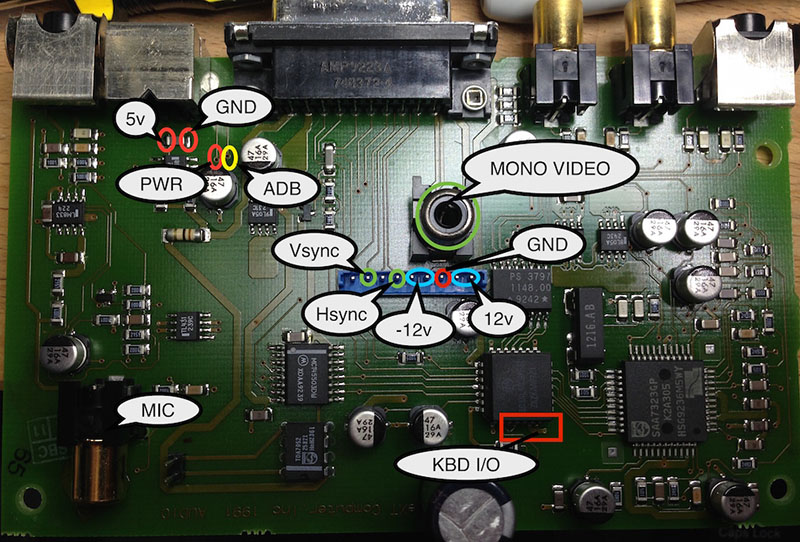The NeXT slabs and cubes were interesting computers for their time, with new interesting applications that are commonplace today seen first in this block of black plastic. Web browsers, for example, were first seen on the NeXT.
Running one of these machines today isn’t exactly easy; there are odd video connectors but you can modify some of the parts and stick them in an LCD monitor. It’s a tradeoff between a big, classic, heavy but contemporary CRT and a modern, light, and efficient LCD, but it’s still a great way to get a cube or slab up and running if you don’t have the huge monitor handy.
The NeXT cube doesn’t have a single wire going between the computer and the monitor; that would be far too simple. Instead, a NeXT Sound Box sits between the two, providing the user a place to plug the monitor, keyboard, mouse, and audio connectors into. [Brian] took the board from this Sound Box and put it inside an old NEC LCD monitor he had sitting around. 12V and 5V rails were wired in, the video lines were wired in, and [Brian] created a new NeXT monitor.
There are two versions of the NeXT Sound Box – one for ADB peripherals (Apple IIgs and beige Macs), and another for non-ADB peripherals. [Brian] also put together a tutorial for using non-ADB peripherals with the much more common ADB Sound Board.
















Welcome to Artifact City!
If you ask me (nobody ever does) the Next computer was Steve Jobs greatest contribution. It was light-years ahead of its time. If he had gone head-to-head with Microsoft in the PC OS market the world might be a little different today. Instead he tried to start up another Apple and found that no one was willing to spend outrageous amounts of money on a proprietary computer with little software written for it that used a cutting edge programming language that didn’t have a developer base.
I remember drooling over the specs, getting shocked at the price and puzzling over the file system
The OS is now open source if anyone wants to play with it.
http://en.m.wikipedia.org/wiki/OpenStep
http://www.gnustep.org
You honestly think that Steve Jobs had anything to do with the hard work that went into any technology Apple makes? Ha! You should read Woz’s biography…
Gnustep is *NOT* OpenStep!
The cubes weren’t plastic, but were magnesium. They were (and still are) interesting machines.
I was going to post this here.
1. Magnesium
2. NeXT’s are as interesting as today’s computers, as there are NO architectural difference from todays most advanced desktop OS’s and those machines. For example, the total separation between GUI and “code” (true Model-View-Controller architecture), was already in place.
Ik would like them gold!
Isnt NeXT video signal differential like Atari TT highres mode?
http://virtuallyfun.superglobalmegacorp.com/?p=3951
The output of the sound box is a fairly standard 13W3, which plugs fine into my VGA monitors with a straightforward adapter cable (although I think my monitors are sync-on-green capable).
Yes, that is correct for the nextstation color series. This mod will not work with those machines as the color signal is broken out at the Y-cable. In that case a simple 13w3 to VGA adapter will work. You can use my other mod for the ADB sound board to use non-adb peripherals. Only the color turbo nextstation can use ADB with the proper ROM installed. No mono signal will come to the sound box. Another thing to mention is that the color machines use a 72hz refresh which can be a problem for many LCDs.
Ah, thanks. Interesting! (Suffice to say I have a turbo color slab, and forgot about the other models.)
ECL is always 1bpp… older SUN3 and NeXT boxes used it, but anything that supported grayscale didn’t.
Even if it doesn’t support the color NeXT machines (well, technically it will on a color cube because you then have two framebuffers) this is a great alternative to the mono Megapixel monitors where the complete lack of power management meant that a lot of the cathodes and heaters in the CRT’s are completely worn out.
Nothing to do with this hack; I’d just like to mention that I’ve got a couple of cubes as coffee table stands/bases. Boards are still there, but I pulled the HD’s out because they’re so heavy.
Beige Macs do not use ADB. ADB was introduced with Mac SE (platinum).
The cubes don’t need a sound box. The display generates sound.